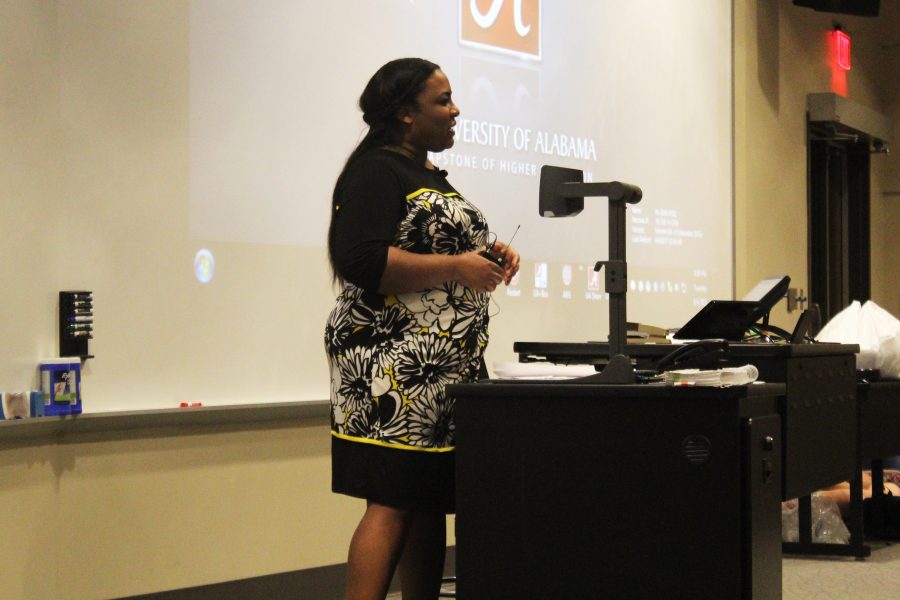According to the U.S. Department of Justice, there are 100,000 to 300,000 children at risk of becoming victims of human trafficking and only about 300 beds for human trafficking victims in the United States. With this statistic in mind, the University of Alabama Criminal Justice Student Association and Alpha Phi Sigma hosted a guest speaking event on Tuesday to raise awareness for the issue.
The guest speakers were Tuscaloosa Police Department Officer Dustin Burroughs, human trafficking survivor Keisha Head and Deputy Director of The Well House Ashley Anderson. Burroughs works on the Alabama human trafficking task force and spoke about staggering statistics, victimology and specific cases he has worked.
Burroughs said the United States produces $9.5 billion yearly from human trafficking. Young boys make up about 45 percent of victims and the average age of entry into prostitution are ages 11-14. He also said the average victim is forced to have sex 20-48 times a day, and the average life expectancy once entered into prostitution is three to seven years.
He talked about the usual routes that traffickers make their victims take for work, and Alabama is in the middle of three large hot spots in the southeast. I-20 is one of the main thoroughfares for human trafficking.
“Basically, Alabama, is right in the triangle,” he said. “You’ll have New Orleans, Atlanta, Memphis, and then all those interstates run straight through Alabama.”
Burroughs said it is difficult to get victims to speak to police because they do not trust them and usually suffer from Stockholm Syndrome, which is when the victim feels assurance or affection toward his or her captor.
Some ways to identify a human trafficking victim are by their rehearsed responses, lack of personal identification and tattoos, he said.
Head, a survivor, recounted her own story of how she became a victim of human trafficking.
After being molested by her adult cousins at age nine, she was taken out of her home only to bounce among 42 different houses during ages 14 and 16, and was on the streets and a single mother by age 16. She was introduced to Sir Charles, who she described as a well-dressed and well-mannered 55-year-old man who drove a Mercedes-Benz.
“There’s no duct tape or chains, there might be, but not often, as we see in the movie Taken,” she said. “It is glamorous, inviting and appealing. Some people view traffickers as one thing, but I view traffickers just as what they are: men who profit off the exploitation of women.”
While Sir Charles originally gave Head hope and listened to all of her deepest secrets, he eventually abused her trust and forced her to have sex for money by threatening the life of her daughter.
“Trafficking happens very quickly,” she said. “There’s a method to it. You are in a vulnerable situation, you need a trafficker, and boom, they provide you with all the solutions and the answers that you need.”
Head said law enforcement has made huge improvements in working human trafficking today. But with the Internet, it is much more accessible than it used to be.
“So this isn’t something that is happening in other countries,” she said. “This is something that could be possibly happening next door. This could be possibly happening in your house, so having conversations with your little sisters and little brothers is one of the things that you can do.”
The final speaker, Ashley Anderson, said The Well House, an organization that works to rescue and restore victims of human trafficking, works closely with law enforcement and the FBI in order to accomplish its mission. It has rescued victims in 25 states to date.
“We don’t just focus our resources on Alabama,” she said. “It is a United States problem, so we actually focus our resources nationally.”
At The Well House, victims are placed into an immediate shelter that provides a bag of full-sized items such as conditioner and deodorant. It also provides healthcare, clothes and safe shelter.
“We don’t give the little baby [sized] stuff because we want [the victims] around for a long time,” she said. “We want this to be a relationship where we begin to show them what independence truly is. We don’t want them to go back into that lifestyle.”
If the victim stays 60 days, she then goes to The Well House’s long-term shelter to get additional help needed, set goals and possibly get a GED or go back to school. Victims are usually with the organization for a year and a half to two years.
“We just want to help them get through that process and help healing,” she said.









